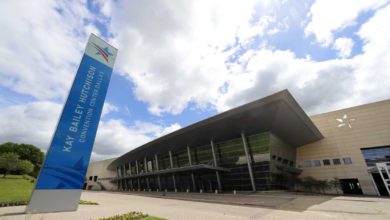

INDEPENDENCE, KY. – A bustling three-way intersection in Northern Kentucky holds more history than drivers and passengers may realize.
Long before the surrounding land became overgrown with bushes and trees, someone built a small cemetery. Here, people decided to memorialize their loved ones — seemingly forever.
Now a project to widen the road in Northern Kentucky means the six unmarked graves must be moved.
Before anything is relocated, the Kentucky Transportation Cabinet would like to find the family members of those buried there. To do that, it started running ads, starting Feb. 4, in the Kenton County Recorder, a weekly newspaper published by The Enquirer.
“I think there’s a perception when you’re put in the ground it’s forever,” said University of Kentucky anthropology expert George Crothers in an interview with The Enquirer. "But it often isn't."

State transportation officials don't keep track of how often this kind of thing happens. Spokesperson Nancy Wood told The Enquirer this is the first case she's seen in her 19 years with the cabinet's District 6 office, which includes the counties of Boone, Bracken, Campbell, Carroll, Gallatin, Grant, Harrison, Kenton, Owen, Pendleton and Robertson.
Graves have been moved in Greater Cincinnati and Kentucky. Experts told The Enquirer it's always better to know about the cemetery before, rather than during, a development project.
In 2002, workers in Frankfort, Kentucky, rediscovered a cemetery with 240 people who had died more than 150 years before, according to a Kentucky archeological survey. Workers moved the bodies because construction had already begun for the Kentucky Transportation Cabinet’s new, six-story, 420,000-square-foot office.
In 2010, 3CDC discovered bones were discovered during the excavation for the Washington Park Garage. They were re-interred at Spring Grove Cemetery and Cincinnati Center City Development Corp. (3CDC) held a special ceremony for the deceased when the park reopened in July 2012, according to The Enquirer archives.

The small cemetery in Northern Kentucky
So far, no one has claimed a relative.
The Kentucky Transportation Department discovered six graves during "archeological research," Wood told The Enquirer, though it's not clear what that research involved.
The $11.5 million road project will improve 5 miles of KY 536 in Kenton County. The two-lane road will become 4-lanes with a raised median and 8-foot-wide paths on both sides, according to the cabinet.
The project is expected to be done by the fall of 2022.
“The cabinet is committed to ensuring a respectful process of relocating unidentified and unmarked graves and will work collaboratively with any family members that contact us,” Wood told The Enquirer in an emailed statement.
The people are buried in an overgrown area near the fork in the road of Mt. Zion Road and Bristow Road in Independence. The cabinet did not share more specific details with The Enquirer because of trespassing and safety concerns.
Joe Hayes' family has owned a farm east of the intersection since the 1960s. He told The Enquirer in an email that he knew about the cabinet's ad, and said the cemetery could be near the white house behind the intersection which is going to be demolished for the project.
It's unclear if other structures will be removed for the road project.
Kentucky bought that house, at 785 Bristow Road, in March for $172,000, according to property records. The Enquirer was unable to reach the previous owners, Melissa Hoffman and Cynthia Doerflein, because their phone line was disconnected.
The ad searching for family members will run until April 1. The bottom of this story has contact information if you or someone you know wants to contact the cabinet.

Moving cemeteries is often ‘inevitable’
Crothers said finding small cemeteries before development projects begin is a “pretty regular” occurrence. He added that it’s preferable to leave them alone, but acknowledged that moving them is often “inevitable.”
“The tradeoff is we need to recover information from the site before it is destroyed,” Crothers said, which is why a big part of his job is maintaining records to alert developers and the state of possible cemeteries before any projects begin.
Anthropologists can tell if someone had a hard labor job if their bones have areas with a rough texture left behind by muscles, Carothers said. The bigger the muscle, the larger the textured area. Researchers also learn about the individual based on what's buried with them, like buttons and belts.
Poul Lemasters, general counsel for the International Cemetery, Cremation & Funeral Association, told The Enquirer cemeteries often have to be moved for the "greater good" of a region.
Lemasters, who works in Cincinnati, said it's more common for small cemeteries to be moved because it's a costly process.
"Maybe we will start to see more of this as we develop our more rural lands," he said.
Do you have any information?
If you or someone you know are related to someone buried at the cemetery, contact Kentucky Transportation Cabinet Right of Way Specialist Amy Ishmael at 606-291-9641.
Julia is the Northern Kentucky government reporter through the Report For America program. The Enquirer needs local donors to help fund her grant-funded position. If you want to support Julia's work, you can donate to her Report For America position at this website or email her editor Carl Weiser at [email protected] to find out how you can help fund her work.
Do you know something she should know? Send her a note at [email protected] and follow her on Twitter at @JFair_Reports.
Don't miss any Northern Kentucky news and sign-up for the NKY.com newsletter here
Source link








